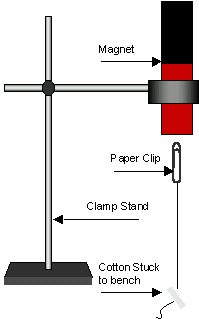School Science/The Indian rope trick (magnetism)
This is a How-to about a School science experiment--Indian rope trick (magnetism). This is a good demonstration that is used in schools to teach the idea of magnetic materials. It can be fiddly to set up, but it's worth the effort.
Materials
edit- Magnet
- Sticky tape or Duct tape
- Samples of materials to insert in the gap
Method
edit- Clamp the magnet in the clamp stand.
- Tie some cotton onto a steel paper clip and allow the paper clip to stick to the magnet.
- Gently pull the cotton down so that there is an air space between the paper clip and the magnet, and then stick it to the bench with some sticky tape. This demonstration works best if the air gap is sufficiently large that the paperclip is only just held up by the magnet. It takes a fair amount of adjustment to get it perfect.
- Insert a non-ferromagnetic material into the air gap, e.g. a piece of paper or a sheet of copper. The paper clip stays up.
- Insert a ferromagnetic material such as an iron nail or sheet of nickel and the paperclip falls.
How does it work?
editThe force that holds the paperclip up is due to an induced magnetic dipole forming in the clip. In other words, if the south pole of the magnet is down, for example, the magnetic domains in the paper clip orient themselves so that the top end of it becomes a north pole, the bottom a south. Like poles repel and opposite poles attract. The attraction of the magnet for the (induced) north pole is greater than the repulsion of the induced south one, because it is closer. That holds the paper clip up. If the north pole of the permanent magnet is down, the same argument applies with north and south interchanged. You can verify that the paper clip has become a miniature magnet, by the way, by showing that iron filings will stick to it, but don't let the filings get on the big magnet or you will have a job cleaning it!
Why is the magnetic field of the bar magnet strongest near its poles? This can be visualized in terms of lines of force that emanate from it, as can be seen by sprinkling iron filings on paper. These lines are called magnetic field lines. The closer the lines are together, the bigger the magnetic flux and the stronger the force pulling magnetisable objects, such as the paperclip, along the lines. Because of the shape of the field lines for a bar-shaped magenet, the places where the lines are closest together are the ends of the magnet.
Magnetic field lines pass straight through most materials, as if the materials were not there. Put a piece of paper in the air gap and the magnetic field lines pass straight through and hold up the paperclip. Some materials, however, affect a magnetic field. They create a magnetic short circuit through which the lines of force pass readily, and so they can't extend on the other side. If you put something made of these materials (known as ferromagnetic materials) into the gap, the field lines distort so as to pass through the short circuit.
If the paperclip is set up so that it is on the brink of falling, then any disturbance in the field that is holding it up will cause it to drop. That's why it is suggested to do the experiment with the clip barely levitated. Otherwise, there is a chance that some of the magnetic lines from the bar magnet may penetrate the inserted lamina or reach round it, and the demonstration will be spoiled.
